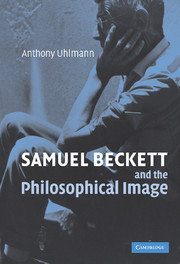Book contents
- Frontmatter
- Contents
- Acknowledgements
- Introduction
- 1 Representation and presentation: Deleuze, Bergson, Peirce and ‘the image’
- 2 Beckett's aesthetic writings and ‘the image’
- 3 Relation and nonrelation
- 4 The philosophical imaginary
- 5 Cogito nescio
- 6 Beckett, Berkeley, Bergson, Film: the intuition image
- 7 The Ancient Stoics and the ontological image
- Conclusion
- Notes
- Works cited
- Index
5 - Cogito nescio
Published online by Cambridge University Press: 22 September 2009
- Frontmatter
- Contents
- Acknowledgements
- Introduction
- 1 Representation and presentation: Deleuze, Bergson, Peirce and ‘the image’
- 2 Beckett's aesthetic writings and ‘the image’
- 3 Relation and nonrelation
- 4 The philosophical imaginary
- 5 Cogito nescio
- 6 Beckett, Berkeley, Bergson, Film: the intuition image
- 7 The Ancient Stoics and the ontological image
- Conclusion
- Notes
- Works cited
- Index
Summary
I, of whom I know nothing
In Difference and Repetition, Proust and Signs and (with Félix Guattari) A Thousand Plateaus and What is Philosophy?, Deleuze develops the concept of ‘the image of thought’. This idea seeks to express how the notion of what it is to think is envisaged or pictured at a given time or place. Such ways of thinking form the basis of implicit presuppositions which underlie ideas and conceptual systems. An ‘image of thought’, then, is a kind of canvas of underlying assumptions upon which the works of a given period are sketched. Deleuze sums up the idea in Negotiations:
By the image of thought I don't mean its method but something deeper that's always taken for granted, a system of coordinates, dynamics, orientations: what it means to think, and to ‘orient oneself in thought’ … The image of thought is what philosophy as it were presupposes; it precedes philosophy, not a nonphilosophical understanding this time but a prephilosophical understanding.
In Difference and Repetition Deleuze describes a ‘dogmatic’ image of thought which has been dominant throughout the history of philosophy, but in A Thousand Plateaus, What is Philosophy? and Negotiations he emphasises how the image is subject to change over time. He asks, ‘Do we, for instance, have the same image of thought that Plato, or even Descartes or Kant, had?’ In What is Philosophy? Deleuze and Guattari discuss such shifts in some detail in their descriptions of ‘the plane of immanence’.
- Type
- Chapter
- Information
- Samuel Beckett and the Philosophical Image , pp. 86 - 113Publisher: Cambridge University PressPrint publication year: 2006



